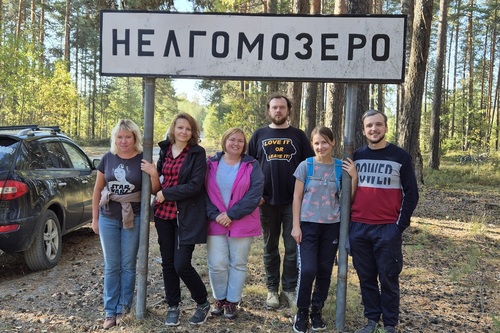– Some villages are unique, they are located at the interface of all three dialects of the Karelian language, reflecting not only dialectal differences, but also self-perception within groups - noted Yulia Litvin, Senior Researcher at the Ethnology Section of the Institute of Linguistics, Literature and History (ILLH KarRC RAS).
The Institute's linguists Alexandra Rodionova, Natalia Pellinen and Svetlana Nagurnaya recorded over 10 hours of audio fragments in Karelian and Russian. The bulk of it is autobiographical and daily-like stories about folk foods, weaving, fishing, harvesting oleoresin and the likes. Also, lyrical and lyro-epic folk and authored songs in Russian and Karelian were recorded.
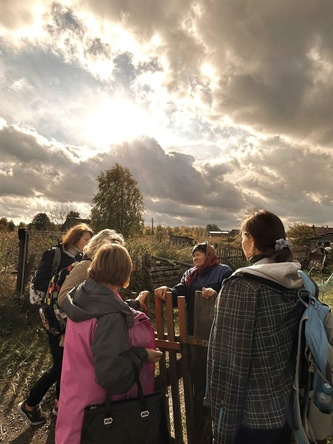
Talking with a women living in the village of Yustozero. Photo by A. Morozov
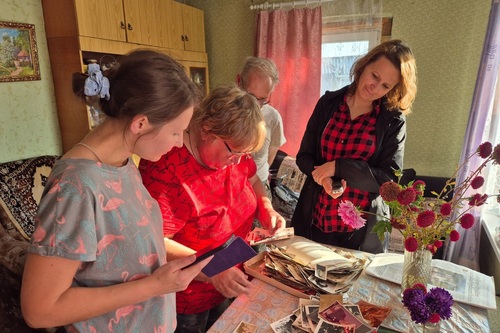
Expedition participants recording an interview with Svetlana Fyodorovna Kondratyeva, a Karelian language teacher and resident of Vokhtozero village
– The language situation in the district was surveyed. A significant part of the informants who can speak Karelian are passive bilinguals,- noted Svetlana Nagurnaya, Head of Linguistics Section ILLH KarRC RAS.
At the same time, in most of the surveyed settlements the researchers managed to record unique samples of Karelian speech, fragments of which will be linked to the Audio Map of Balto-Finnic Languages of Karelia and adjacent regions in VepKar corpus.
Ethnology Section staff explored folk beliefs, necroculture, and collected material on identity.
– People in the villages we visited still remember travel prayers and healing incantations and use them in daily life. Some interlocutors recalled the Old Believer past of their area. Narratives were recorded about ritual specialists - senior aged women who in Soviet times conducted funeral rites and performed the functions of priests. The custom of waffing the deceased with a piece of cloth or a handkerchief during viewing (Kar. pyyhkiä paikal) proved to be quite persistent in the area. All the informants interviewed recalled it, - said Sergey Minvaleev, Researcher at the Ethnology Section ILLH KarRC RAS.
Six cemeteries were examined during the expedition, and almost all of them shared a distinctive common feature - an abundance of textiles tied to grave railings and tables, trees and crosses (Kar. tuulipaikka 'wind scarf'). In some cases, “wind scarves” are still used in ritual waffing of the grave when visiting the cemetery.
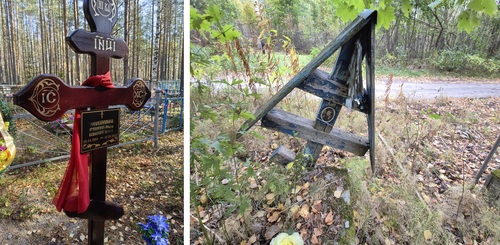
Tuulipaikka ‘wind scarves’ in Svyatnavolok village cemetery. Photos by Yu. Litvin and S. Minvaleev
– The identity of Karelians in the surveyed communities is characterized by high plasticity, which is due, on the one hand, to the dynamic boundary between dialects of the Karelian language and, accordingly, to the perception of speech even from neighboring villages as different (“we wouldn't put it this way here”), and on the other hand, to the fact that many settlements were located in or near former high roads, along trade routes. The latter created grounds for a smoother linguistic and cultural convergence with the Russian population and facilitated marital contacts, for example, with inhabitants of the neighboring Zaonezhye area. Industrial development of the Kondopoga District in Soviet times attracted workers from different regions of the USSR. The multiethnic environment influenced the language shift situation, as well as the self-perception of Karelians and their identity, – added Yulia Litvin.
The expedition was joined by Junior Researcher at the Department for Regional Institutional Development, Institute of Economics KarRC RAS, Arseniy Morozov. He studied the tourist potential of the territory. The specialist noted that the key to the communities' tourism appeal is their cultural and natural aspects. The villages are located near highways and can be integrated into the general tourist traffic by becoming part of larger routes.
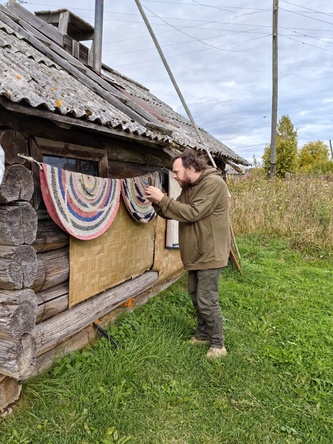
Arseniy Morozov, employee of the Institute of Economics KarRC RAS, taking pictures of a bathhouse and floor mats in the village of Tivdia. Photo by Yu. Litvin




